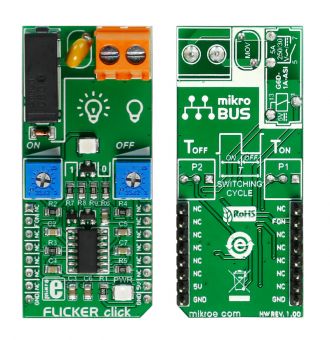
We strongly encourage users to use Package manager for sharing their code on Libstock website, because it boosts your efficiency and leaves the end user with no room for error. [more info]

Rating:
Author: MIKROE
Last Updated: 2019-03-28
Package Version: 1.0.0.1
mikroSDK Library: 1.0.0.0
Category: Relay
Downloaded: 5021 times
Not followed.
License: MIT license
FLICKER click is perfect, simple solution if you need to turn a device on and off at specific time intervals, like blinking LED commercials, alarm system lights, or any other signalling lights.
This example shows how by using the button you can start time relay and configure it's duration of on and off period.
Do you want to subscribe in order to receive notifications regarding "Flicker click" changes.
Do you want to unsubscribe in order to stop receiving notifications regarding "Flicker click" changes.
Do you want to report abuse regarding "Flicker click".

Library Description
The library covers all functions to control Flicker click board.
Key functions:
Examples Description
The application is composed of three sections:
void applicationTask()
{
mikrobus_logWrite( " *Flicker on!* ", _LOG_LINE );
flicker_engage();
}
Other mikroE Libraries used in the example:
Additional notes and informations
Depending on the development board you are using, you may need USB UART click, USB UART 2 click or RS232 click to connect to your PC, for development systems with no UART to USB interface available on the board. The terminal available in all MikroElektronika compilers, or any other terminal application of your choice, can be used to read the message